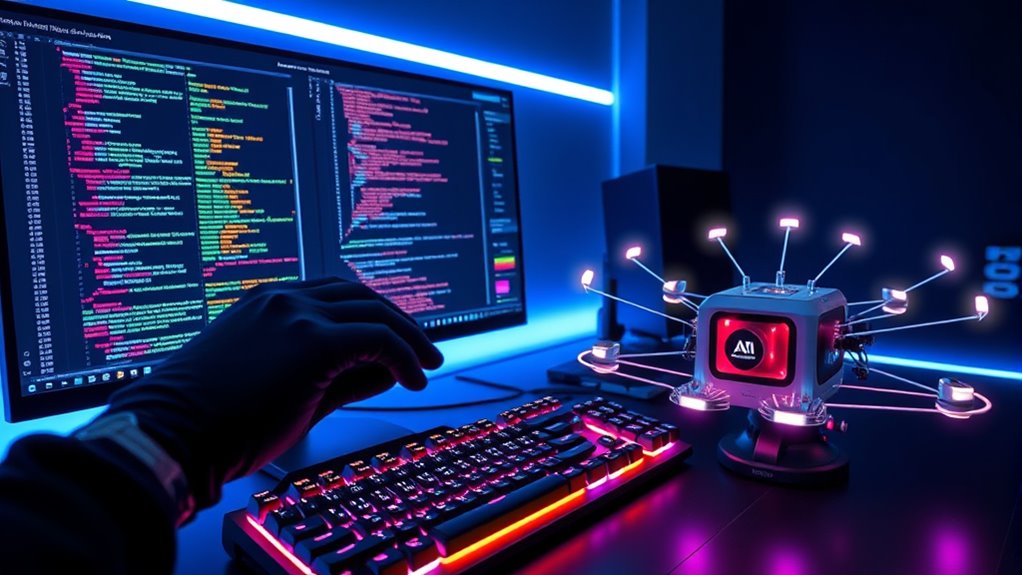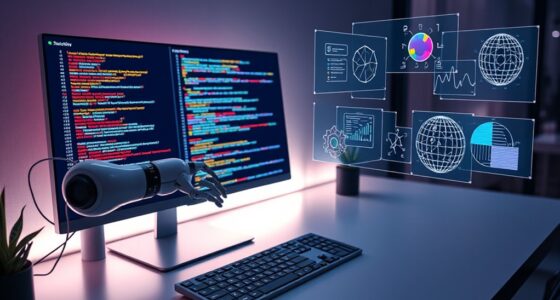AI-assisted debugging uses advanced machine learning techniques to identify, prioritize, and prevent software errors proactively. It analyzes large datasets, such as error reports and code changes, to spot subtle patterns and anomalies. These tools offer real-time feedback, helping you catch issues early and improve code quality efficiently. By integrating with your development environment, they adapt to your coding style and project-specific needs. Continue exploring to discover more ways AI can transform your debugging process.
Key Takeaways
- Machine learning models analyze code patterns and runtime data to detect subtle, hard-to-find errors automatically.
- AI tools prioritize bugs based on impact and recurrence, optimizing debugging efforts efficiently.
- Predictive analytics forecast potential issues, enabling proactive fixes during development cycles.
- Seamless integration with IDEs offers real-time feedback and personalized suggestions to prevent errors early.
- Continuous learning algorithms adapt to evolving codebases, enhancing software quality and reliability over time.

AI-assisted debugging is transforming how developers identify and fix errors in software. By leveraging the power of machine learning, these tools analyze vast amounts of data to detect patterns and anomalies that would be difficult or time-consuming to find manually. Instead of relying solely on traditional debugging methods, you now have access to intelligent systems that can pinpoint issues with remarkable speed and accuracy. These systems learn from previous error reports, code changes, and runtime behaviors to improve their accuracy over time, making error analysis more efficient and less error-prone.
When you utilize AI for debugging, error analysis becomes more extensive. Machine learning models examine code execution logs, stack traces, and user reports to identify the root causes of bugs. They can recognize subtle patterns, such as specific sequences of code that tend to lead to crashes or performance issues, which might escape human notice. This capability allows you to focus your attention on the most critical problems, saving you hours of manual investigation. Moreover, error analysis with AI tools can assist in prioritizing bugs based on their impact or frequency, ensuring that your team addresses the most pressing issues first. Additionally, integrating these tools with quality assurance metrics can help track improvements over time and evaluate the effectiveness of debugging efforts.
These advanced techniques also enable predictive insights. By analyzing historical error data, AI can forecast potential problem areas in your code before they manifest as visible bugs. This proactive approach helps you implement fixes earlier in the development cycle, reducing downtime and improving overall software quality. Machine learning algorithms can adapt dynamically as your codebase evolves, continuously refining their understanding of typical error patterns and suggesting targeted solutions. Furthermore, incorporating machine learning techniques helps in creating more adaptive and intelligent debugging systems that evolve alongside your projects.
In addition, AI-assisted debugging tools often integrate seamlessly with your development environment, providing real-time feedback and suggestions. As you write or modify code, these systems can flag potential issues instantly, guiding you toward more robust and error-resistant code. They also learn from your coding style and preferences, tailoring their recommendations to fit your specific project context. This personalized assistance accelerates debugging, minimizes frustration, and enhances your productivity. Incorporating software quality assurance best practices ensures that these tools contribute effectively to maintaining high standards of code quality and reliability.
Frequently Asked Questions
How Does AI Handle Ambiguous or Incomplete Bug Reports?
When you submit ambiguous or incomplete bug reports, AI uses natural language processing to interpret your descriptions. It leverages context understanding to fill in gaps and clarify details, making educated guesses about the problem. This helps the AI prioritize issues and suggest potential solutions, even with limited information. By analyzing patterns and previous data, it improves accuracy over time, assisting you effectively despite initial uncertainties.
Can AI Identify Performance Bottlenecks Beyond Code Errors?
Think of AI as a detective scanning a complex city map. It doesn’t just find code errors but also spots performance bottlenecks through performance profiling. You can rely on AI to analyze runtime data, identify slow or inefficient processes, and suggest code optimization strategies. This helps you enhance system performance, streamline workflows, and guarantee your app runs smoothly beyond just fixing bugs. AI’s insight extends deep into the architecture, revealing hidden performance traps.
What Are the Limitations of AI in Debugging Multi-Language Projects?
You might find AI struggles with debugging multi-language projects because it lacks deep contextual understanding of how different languages interact. Cross-language integration complicates AI’s ability to accurately trace issues, especially when syntax or runtime behaviors vary. Limitations include difficulty interpreting diverse codebases, managing different frameworks, and understanding project-specific nuances. As a result, AI tools may miss subtle bugs or provide incomplete solutions, requiring human expertise for complex, multi-language debugging tasks.
How Does AI Prioritize Which Bugs to Fix First?
You prioritize bugs based on their severity and fix complexity. High-severity bugs that impact functionality or user experience come first, ensuring critical issues are resolved quickly. You also consider fix complexity; simpler bugs are tackled earlier to free up resources for more complex problems. This approach helps you efficiently manage your workflow, focusing on what matters most and ensuring a smoother development process.
Is Ai-Assisted Debugging Suitable for Real-Time Systems?
You might wonder if AI-assisted debugging suits real-time systems. It can be effective, especially when integrated with hardware and optimized for low latency. A seamless user interface helps you quickly identify and address issues without slowing system performance. However, you should guarantee the AI’s response time aligns with your system’s real-time requirements, so it doesn’t introduce delays or compromise critical operations.
Conclusion
AI-assisted debugging transforms how you identify and fix issues faster. While some believe it’s just automation, recent studies suggest it enhances human intuition, making debugging more accurate. You might think AI replaces your skills, but it actually complements them, revealing hidden bugs and patterns you might miss. Embracing these advanced techniques could challenge your traditional approach, proving that collaboration between humans and AI leads to more reliable software. Ultimately, it’s a partnership that pushes debugging beyond previous limits.









